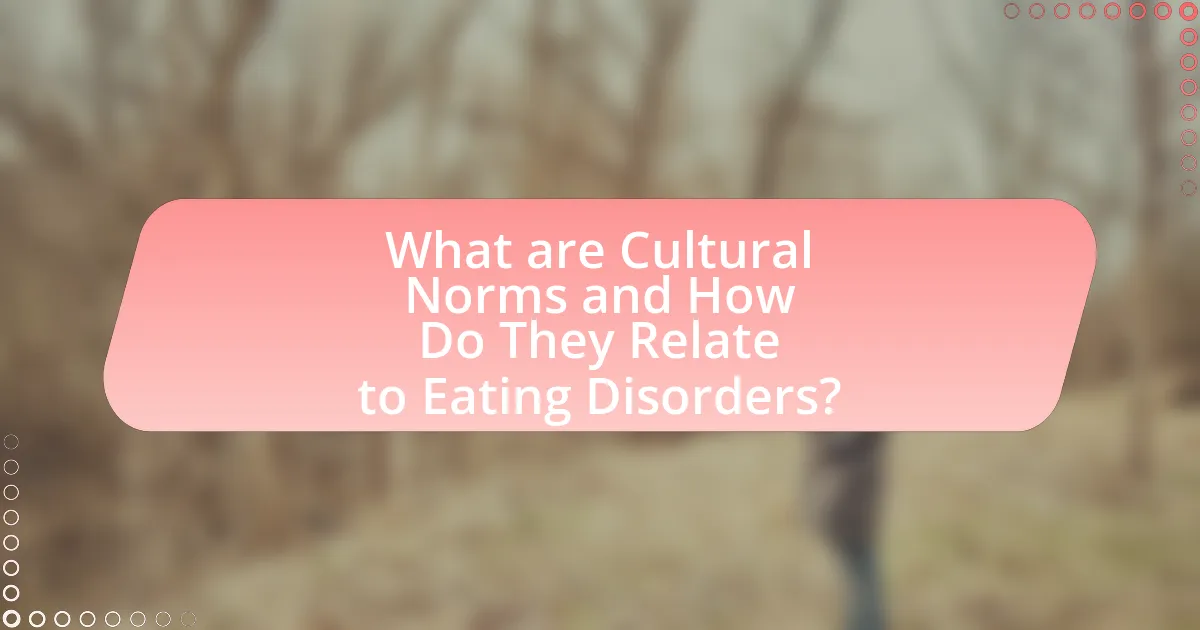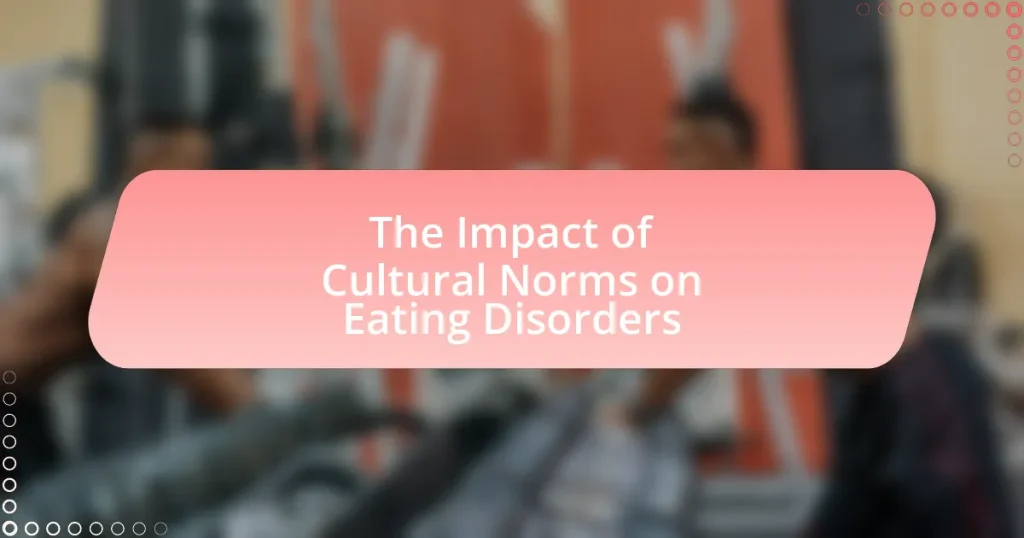Cultural norms are the shared expectations that influence individual behaviors and perceptions, particularly regarding body image and eating practices. This article examines how these norms contribute to the development of eating disorders, such as anorexia nervosa, bulimia nervosa, and binge eating disorder, by promoting unrealistic beauty standards often perpetuated through media and societal pressures. It explores the impact of cultural attitudes towards food, the role of media in reinforcing these norms, and the psychological consequences of adhering to such ideals. Additionally, the article discusses strategies to mitigate the influence of harmful cultural norms, emphasizing the importance of awareness, education, and culturally sensitive mental health practices.

What are Cultural Norms and How Do They Relate to Eating Disorders?
Cultural norms are the shared expectations and rules that guide behavior within a society, influencing individuals’ perceptions of acceptable practices, including those related to body image and eating. These norms can significantly contribute to the development of eating disorders by promoting unrealistic standards of beauty and thinness, often perpetuated through media representations and societal pressures. For instance, research indicates that cultures emphasizing thinness as an ideal correlate with higher rates of anorexia and bulimia, particularly among women. A study published in the “International Journal of Eating Disorders” by Stice and Shaw (2002) found that exposure to media images promoting thinness increased body dissatisfaction and disordered eating behaviors among young women. Thus, cultural norms play a crucial role in shaping attitudes toward food and body image, directly impacting the prevalence of eating disorders.
How do cultural norms shape perceptions of body image?
Cultural norms significantly shape perceptions of body image by establishing standards of beauty and desirability that individuals internalize. These norms vary across different societies and can dictate what is considered attractive, leading to pressure to conform to specific body types. For example, in Western cultures, thinness is often idealized, which has been linked to increased rates of eating disorders, as evidenced by research from the National Eating Disorders Association, which states that societal pressures contribute to body dissatisfaction and unhealthy behaviors. Conversely, some cultures may celebrate larger body sizes as symbols of wealth and health, demonstrating that cultural context plays a crucial role in shaping individual perceptions of body image.
What specific cultural factors influence body image ideals?
Cultural factors that influence body image ideals include media representation, societal norms, and cultural values. Media representation, particularly in advertising and entertainment, often promotes specific body types as desirable, leading individuals to internalize these ideals. For example, studies show that exposure to thin models in fashion media correlates with body dissatisfaction among women. Societal norms dictate what is considered attractive, which can vary significantly across cultures; in some cultures, a fuller body is associated with wealth and health, while in others, thinness is idealized. Additionally, cultural values, such as the emphasis on individualism or collectivism, can shape body image perceptions, with individualistic societies often prioritizing personal appearance over communal acceptance. These factors collectively contribute to the formation of body image ideals that can impact mental health and contribute to eating disorders.
How do these ideals contribute to the development of eating disorders?
Cultural ideals of thinness and beauty significantly contribute to the development of eating disorders by creating unrealistic standards that individuals feel pressured to meet. These societal norms often glorify slender body types while stigmatizing larger bodies, leading to body dissatisfaction among individuals, particularly women. Research indicates that exposure to media portraying idealized body images correlates with increased risk of disordered eating behaviors; for instance, a study published in the journal “Eating Disorders” found that women who frequently consume media with thin-ideal images are more likely to engage in dieting and binge eating. This pressure to conform to cultural ideals can trigger psychological distress, ultimately resulting in conditions such as anorexia nervosa and bulimia nervosa.
What role does media play in reinforcing cultural norms around eating?
Media plays a significant role in reinforcing cultural norms around eating by shaping perceptions of ideal body types and food choices. Through advertisements, television shows, and social media, media outlets often promote specific dietary habits and body images that align with societal standards. For instance, studies have shown that exposure to thin-ideal images in media correlates with increased body dissatisfaction among viewers, particularly young women, leading to unhealthy eating behaviors. Research published in the journal “Eating Disorders” by Tiggemann and Slater (2014) found that adolescents who frequently engage with social media are more likely to internalize these cultural norms, which can contribute to the development of eating disorders. Thus, media not only reflects but actively perpetuates cultural norms surrounding eating and body image.
How does media representation affect individual eating behaviors?
Media representation significantly influences individual eating behaviors by shaping perceptions of body image and food choices. Research indicates that exposure to idealized body types in media can lead to body dissatisfaction, which is linked to unhealthy eating practices such as restrictive dieting or binge eating. For instance, a study published in the journal “Health Psychology” by Tiggemann and Slater (2014) found that young women who frequently viewed thin-ideal images reported higher levels of disordered eating behaviors. This demonstrates that media portrayals not only affect self-esteem but also directly impact dietary habits and overall health.
What are the consequences of unrealistic portrayals of body types in media?
Unrealistic portrayals of body types in media lead to negative psychological and physical consequences, including increased body dissatisfaction, low self-esteem, and the development of eating disorders. Research indicates that exposure to idealized body images can trigger unhealthy behaviors, such as extreme dieting and excessive exercise, as individuals strive to attain these unattainable standards. A study published in the journal “Eating Disorders” found that individuals who frequently consume media featuring thin ideals are more likely to experience disordered eating patterns and body image issues. Furthermore, the prevalence of these portrayals contributes to societal norms that equate worth with appearance, exacerbating mental health issues and perpetuating a cycle of body shame and unhealthy behaviors.
How do cultural attitudes towards food impact eating disorders?
Cultural attitudes towards food significantly impact the prevalence and manifestation of eating disorders. Societies that emphasize thinness and associate it with success and beauty often contribute to higher rates of disorders such as anorexia and bulimia. For instance, research published in the “International Journal of Eating Disorders” by Stice et al. (2009) indicates that individuals in cultures with strong thin-ideal pressures are more likely to engage in disordered eating behaviors. Additionally, cultural norms surrounding food can dictate what is considered acceptable eating behavior, leading to restrictive diets or binge eating as individuals attempt to conform to these ideals. This relationship underscores the importance of understanding cultural context when addressing eating disorders.
What cultural practices around food can lead to disordered eating?
Cultural practices around food that can lead to disordered eating include strict dietary restrictions, the glorification of thinness, and the use of food as a means of social control. Strict dietary restrictions, often rooted in cultural or religious beliefs, can create an unhealthy relationship with food, leading individuals to develop binge-eating or restrictive eating behaviors. The glorification of thinness, prevalent in many cultures, can pressure individuals to pursue unrealistic body standards, resulting in behaviors such as excessive dieting or purging. Additionally, using food as a means of social control, where certain foods are deemed acceptable or unacceptable based on cultural norms, can contribute to feelings of guilt or shame around eating, further exacerbating disordered eating patterns. These practices are supported by research indicating that cultural influences significantly shape individual attitudes toward food and body image, thereby increasing the risk of eating disorders.
How do societal expectations influence dietary habits?
Societal expectations significantly influence dietary habits by shaping perceptions of ideal body types and food choices. These expectations often promote specific diets and eating behaviors that align with cultural ideals, leading individuals to adopt restrictive eating patterns or unhealthy food practices. For instance, research indicates that media portrayals of thinness as a standard of beauty can lead to increased dieting and disordered eating among individuals, particularly women. A study published in the journal “Eating Disorders” by Stice et al. (2017) found that exposure to thin-ideal media was associated with greater body dissatisfaction and unhealthy eating behaviors. Thus, societal norms directly impact dietary choices, often resulting in negative health outcomes.

What Are the Different Types of Eating Disorders Influenced by Cultural Norms?
Different types of eating disorders influenced by cultural norms include anorexia nervosa, bulimia nervosa, binge eating disorder, and orthorexia. Anorexia nervosa is characterized by extreme restriction of food intake and an intense fear of gaining weight, often driven by societal ideals of thinness. Bulimia nervosa involves cycles of binge eating followed by compensatory behaviors such as vomiting or excessive exercise, frequently influenced by cultural pressures to maintain a certain body image. Binge eating disorder is marked by recurrent episodes of eating large quantities of food without purging, often linked to emotional distress and societal expectations around food. Orthorexia, while not officially recognized as a clinical diagnosis, refers to an unhealthy obsession with eating only healthy foods, which can stem from cultural ideals surrounding health and wellness. Research indicates that cultural factors significantly shape the prevalence and manifestation of these disorders, as seen in studies highlighting the correlation between media portrayals of body image and the rise of eating disorders in various populations.
What are the most common eating disorders linked to cultural influences?
The most common eating disorders linked to cultural influences are anorexia nervosa, bulimia nervosa, and binge eating disorder. Anorexia nervosa is often influenced by cultural ideals of thinness, particularly in Western societies, where media portrayals emphasize slim body types as desirable. Bulimia nervosa frequently arises in cultures that promote dieting and weight control, leading individuals to engage in cycles of binge eating followed by purging. Binge eating disorder is also prevalent in cultures that stigmatize obesity, causing individuals to eat excessively in response to emotional distress or societal pressures. Research indicates that cultural factors, such as media representation and societal expectations, significantly contribute to the prevalence and manifestation of these disorders, highlighting the interplay between cultural norms and eating behaviors.
How does anorexia nervosa manifest in different cultures?
Anorexia nervosa manifests differently across cultures, influenced by varying societal norms and ideals of beauty. In Western cultures, the disorder often correlates with an obsession for thinness, driven by media portrayals that glorify slim bodies, leading to increased prevalence among young women. Conversely, in some non-Western cultures, such as certain African and Asian societies, the ideal body type may lean towards being fuller, which can result in lower rates of anorexia. However, globalization and exposure to Western media have begun to shift these ideals, causing an increase in anorexia cases even in cultures traditionally less affected by it. Research indicates that cultural factors, including family dynamics and social pressures, play a significant role in the manifestation of anorexia, highlighting the complex interplay between culture and mental health.
What cultural factors contribute to bulimia nervosa prevalence?
Cultural factors significantly contribute to the prevalence of bulimia nervosa, particularly through societal ideals of thinness and beauty. In many Western cultures, media portrayals emphasize slim body types as the standard for attractiveness, leading individuals to internalize these ideals and engage in disordered eating behaviors to achieve them. Research indicates that exposure to media images promoting thinness correlates with increased body dissatisfaction and eating disorders among women, as highlighted in a study by Stice and Shaw (2002) published in the Journal of Abnormal Psychology. Additionally, cultural pressures surrounding food and body image, such as the stigma against obesity and the glorification of dieting, further exacerbate the risk of developing bulimia nervosa. These cultural norms create an environment where individuals feel compelled to conform to unrealistic body standards, increasing the likelihood of disordered eating patterns.
How do cultural norms affect the prevalence of binge eating disorder?
Cultural norms significantly influence the prevalence of binge eating disorder by shaping attitudes toward body image, food, and emotional expression. In cultures that prioritize thinness and associate it with success, individuals may engage in binge eating as a coping mechanism for stress or dissatisfaction with their bodies. Research indicates that societies with high levels of media exposure promoting idealized body types correlate with increased rates of eating disorders, including binge eating disorder. For instance, a study published in the “International Journal of Eating Disorders” by Stice et al. (2009) found that exposure to thin-ideal media increased the risk of disordered eating behaviors among young women. Thus, cultural pressures and ideals can create an environment where binge eating becomes a prevalent response to societal expectations and personal struggles.
What societal pressures lead to binge eating in various cultures?
Societal pressures that lead to binge eating in various cultures include the emphasis on thinness, cultural norms surrounding food, and social media influences. In many Western cultures, the idealization of thinness creates a stigma against larger body types, prompting individuals to engage in restrictive dieting, which can lead to binge eating as a compensatory behavior. Additionally, cultural celebrations often involve large quantities of food, which can normalize overeating and contribute to binge eating patterns. Social media platforms further exacerbate these pressures by promoting unrealistic body images and food-related content, leading to increased body dissatisfaction and unhealthy eating behaviors. Research indicates that individuals exposed to idealized body images on social media are more likely to develop disordered eating habits, including binge eating.
How do cultural attitudes towards weight gain influence binge eating behaviors?
Cultural attitudes towards weight gain significantly influence binge eating behaviors by shaping individuals’ perceptions of body image and self-worth. In cultures that stigmatize weight gain and promote thinness as an ideal, individuals may experience heightened pressure to conform, leading to feelings of inadequacy and low self-esteem. This psychological distress can trigger binge eating as a coping mechanism. Research indicates that in societies where thinness is glorified, such as in Western cultures, the prevalence of binge eating disorder is notably higher, with studies showing that 1-3% of women in these cultures may experience this disorder. Conversely, cultures that embrace larger body sizes as symbols of health and prosperity tend to report lower rates of binge eating behaviors, highlighting the direct correlation between cultural norms and eating disorders.

What Strategies Can Help Mitigate the Impact of Cultural Norms on Eating Disorders?
To mitigate the impact of cultural norms on eating disorders, implementing educational programs that promote body positivity and diversity in body shapes is essential. These programs can challenge harmful stereotypes and encourage acceptance of various body types, which has been shown to reduce the prevalence of eating disorders. Research indicates that exposure to body-positive media can significantly improve self-esteem and body image among individuals, thereby decreasing the risk of developing eating disorders. Additionally, fostering open discussions about mental health and eating behaviors within communities can create supportive environments that counteract negative cultural influences.
How can awareness of cultural norms reduce the risk of eating disorders?
Awareness of cultural norms can reduce the risk of eating disorders by promoting a healthier understanding of body image and food behaviors. When individuals recognize that cultural standards often dictate unrealistic body ideals, they can develop a critical perspective that challenges these norms. Research indicates that exposure to diverse body representations and the understanding that beauty standards vary across cultures can lead to improved body satisfaction and reduced disordered eating behaviors. For instance, a study published in the “International Journal of Eating Disorders” found that individuals who engaged in discussions about cultural diversity in body image reported lower levels of body dissatisfaction and eating disorder symptoms. This highlights the importance of cultural awareness in fostering resilience against the pressures that contribute to eating disorders.
What educational programs can promote healthy body image?
Educational programs that can promote healthy body image include media literacy programs, body positivity workshops, and school-based health education curricula. Media literacy programs teach individuals to critically analyze media messages about body image, helping them recognize unrealistic standards and develop resilience against negative influences. Body positivity workshops encourage self-acceptance and appreciation of diverse body types, fostering a supportive environment. School-based health education curricula often incorporate lessons on nutrition, physical activity, and self-esteem, which can positively influence students’ perceptions of their bodies. Research indicates that such educational interventions can significantly reduce body dissatisfaction and improve overall mental health outcomes among participants.
How can communities challenge harmful cultural norms related to eating?
Communities can challenge harmful cultural norms related to eating by promoting body positivity and inclusive representations of diverse body types. Initiatives such as educational campaigns that highlight the negative impacts of dieting culture and unrealistic beauty standards can foster awareness. Research indicates that exposure to body-positive media can reduce the prevalence of eating disorders, as seen in studies published in the Journal of Eating Disorders, which demonstrate that individuals who engage with diverse body representations report improved body image and self-esteem. Additionally, community support groups can provide safe spaces for individuals to share experiences and challenge societal pressures collectively, reinforcing the message that health comes in various forms.
What role do mental health professionals play in addressing cultural influences?
Mental health professionals play a crucial role in addressing cultural influences by providing culturally competent care that acknowledges and integrates the cultural backgrounds of their clients. They assess how cultural norms shape individuals’ perceptions of body image, eating behaviors, and mental health, which is essential in treating eating disorders. For instance, research indicates that cultural ideals of beauty can significantly impact self-esteem and eating habits, leading to disorders such as anorexia and bulimia. By understanding these cultural contexts, mental health professionals can tailor interventions that resonate with clients’ experiences, thereby improving treatment outcomes and fostering a supportive therapeutic environment.
How can therapists incorporate cultural sensitivity in treatment?
Therapists can incorporate cultural sensitivity in treatment by actively understanding and respecting the diverse cultural backgrounds of their clients. This involves conducting thorough assessments that include cultural factors, utilizing culturally relevant therapeutic techniques, and fostering an open dialogue about cultural beliefs and practices. Research indicates that culturally sensitive therapy can lead to improved client engagement and outcomes, as evidenced by a study published in the “American Journal of Orthopsychiatry,” which found that culturally adapted interventions significantly enhanced treatment effectiveness for clients from diverse backgrounds.
What best practices can be adopted to support individuals from diverse backgrounds?
To support individuals from diverse backgrounds, organizations should implement culturally competent practices that acknowledge and respect different cultural perspectives. These practices include providing training for staff on cultural sensitivity, ensuring access to multilingual resources, and creating inclusive environments that celebrate diversity. Research indicates that culturally tailored interventions can significantly improve engagement and outcomes in mental health services, as evidenced by a study published in the American Journal of Psychiatry, which found that culturally adapted treatments led to better adherence and satisfaction among minority populations.
What practical steps can individuals take to combat negative cultural influences?
Individuals can combat negative cultural influences by actively promoting body positivity and critical media consumption. Engaging in discussions that challenge harmful stereotypes and unrealistic beauty standards helps create a supportive environment. Research indicates that exposure to diverse body representations can reduce the internalization of negative cultural norms, as shown in a study published in the Journal of Eating Disorders, which found that individuals who viewed positive body image media reported lower levels of body dissatisfaction. Additionally, practicing mindfulness and self-compassion can empower individuals to resist societal pressures, fostering a healthier self-image and reducing the risk of eating disorders.


